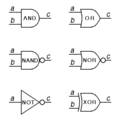Tanmay's Design Study
Contents |
Introduction
Welcome to the world of Digital Logic. Ever wondered what they teach at the College of Engineering that is different from the material taught at Department of Computer Science and Software Engineering ? Being a computer engineering student, I thought I would take this opportunity to perform Object-Oriented Analysis and Design of a 'Digital Logic Circuit Simulator'.Digital Circuits, that are constructed by joining simple logic elements, form the basis of our 'Embedded Systems' oriented programme.
Outline
A digital logic simulator gives the user the ability to join simple logic elements to study the behaviour of complex digital circuits. My approach to this problem would be designing an 'Event Driven Simulator' where events (change in state of something) triggers further events in the system that happen at a later time. This model of this simulator will revolve around the elementary components from which the circuit is constructed as well as the time-events taking place in the system. These can be further broken down into :
- 1) Wires --- Carry binary logic signals between components
- 2) Digital Function Blocks --- These perform some special function to generate output signal(s) based on some inputs. They need to listen for changes in the state of wires connecting these blocks.
- 3) Events --- to help model the time delay of performing various tasks during the simulation. A change in the state of 1 wire might trickle down to changes in the neighboring wires based on the output of the connecting function blocks.
My primary focus for this design study would remain on the core classes of the simulator rather than its GUI implementation.
Background
User Stories
Requirements
- 1) Adding Components :
A User should be able to add new components to the system. These components can be a basic logic element or a combination of a series of elements.
- 2) Connecting Components with Wires
A user should be able to assign connecting wires to the component inputs/ outputs.
- 3) Running the Simulation
Once the circuit has been wired up, a user should be able to run the simulation and view the results via a component like a probe.


